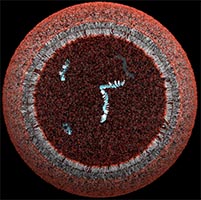The first self-organizing membranous bundles of
chemicals, arising spontaneously from inanimate
materials and surrounded by lipids made the early Earth
protocells. But these protocells almost certainly had to
replicate without relying on large proteins. How they
might have replicated is a key question for
astrobiologists and biochemists studying the origins of
life.
A mathematical model by R. Attal (Biophysical Journal)
proposes that heat alone may have
promoted fission of one protocell into two.
Metabolic-like chemical reactions within a lipid
membrane could isolate protocell metabolism from the
randomness in the rest of Earth’s primordial chemical
world and this partitioning,
provided by the lipid membrane, might
create an area of lower entropy.
Mitochondria, which are capable of fissionable division, have a slightly higher internal temperature than the cytoplasm.
Mitochondria, which are capable of fissionable division, have a slightly higher internal temperature than the cytoplasm.
Attal's theoretical thermodynamic model suggests that
the heat generated could cause lipid bilayers regions to
flip expanding the surrounding membrane and possibly
result in the protocell pinching into two.
While the model may not be the most accurate, it is a
starting point for further experiments. Chemical
reactions do generate heat, which could have an effect
on things like protocell fission.
